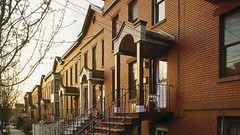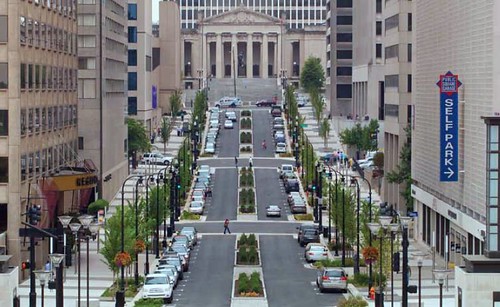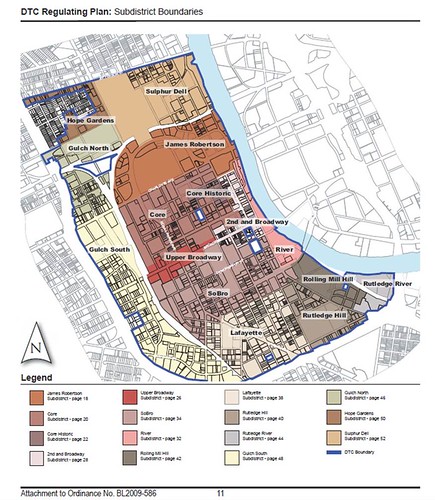Zoning reform strengthens Nashville's impressive sustainability efforts

Posted February 29, 2012 at 3:01PM
A city cited not long ago as the nation’s most sprawling is now firmly on a path to become substantially greener. In particular, two weeks ago I described the Nashville region’s impressive commitment to reform its transportation investments to support increased transit access, walkable neighborhoods, and a strengthened sense of place. And there’s more.
Writing on his blog Old Urbanist, Charlie Gardner describes recent improvements to the Music City’s downtown zoning:
“In addition to its plans for the region, Nashville has revamped its zoning code, adopting in 2010 what is in substance, if not in name, a form-based code for its downtown. The changes are some of the most promising I've seen in any code revision for a major American city, including the repeal of most of use-based zoning limitations and the elimination of all parking minimums within the downtown area. It's a long overdue change for a downtown with a particularly tragic 20th century planning history.”
The new zoning code has been designed explicitly to give legal expression to a “Downtown Community Plan” adopted in 2007 to strengthen the character and walkability of downtown neighborhoods. The city hopes these neglected areas will evolve into “24-hour” districts that host residential as well as commercial uses.
To accomplish this, the new code regulates the form of buildings so that, for example, building height guidelines allow increased density in logical patterns but building uses are allowed to vary to encourage mixed uses so long as they support an inviting streetscape:
“In an urban environment, the street level design and function of a building is of the utmost importance. The interaction of the building with the street should enliven the street, making it comfortable, safe and interesting for pedestrians. The DTC is based on frontage design – storefront, stoop, porch, industrial, and civic – and includes standards on glazing, vehicular access, landscaping, and active uses on the ground level. Correctly designed, these attributes will contribute to safe and interesting streets to result in vibrant neighborhoods and a healthy Downtown.”
Downtown residential living and neighborhood character are explicit goals of the new code:
“The Plan calls for a ‘thoughtful mixture of uses including residential, retail and office, to ensure that Downtown doesn’t close at 5 p.m. or even after the concert ends or the restaurants close, but is instead a welcoming home for a diverse residential population.’
Multiple stories encourage multiple uses within each building, increasing the likelihood that one of the uses will be active at any given hour. Compare this to one story buildings which lack activity during the off-hours of the single use.
“To be viable, Downtown must accommodate numerous services and functions. By promoting form over use, the DTC allows for a mixture of uses. Because various functions occur at different times of the day – working, shopping and recreating during the day, entertainment and home-life at night – mixed-use, 24/7 neighborhoods use existing infrastructure more efficiently and function in a more sustainable way . . .
“As stated in the Plan, ‘While residential development has flourished in recent years, the creation and enhancement of urban neighborhoods is still a goal. Residential living will thrive in Downtown when residents feel that they are part of a neighborhood, supported by shared public spaces and the services and amenities needed for daily life.’”
In comments on his article, Gardner clarifies that, for zoning purposes, “downtown” takes in several residential neighborhoods, extending from the central business district out to the edges of neighborhoods that are characterized by single-family, detached homes.
While Nashville’s core has experienced some progressive, mixed-use redevelopment in recent years – most notably The Gulch, an ambitious repurposing of an old railroad yard into the South’s first LEED-ND-certified neighborhood – it has been piecemeal, requiring zoning changes or variances in every instance while leaving nearby tracts unaffected. Indeed, many are simply dominated by expansive surface parking lots, among the least sustainable and pedestrian-friendly uses of urban land.
The new zoning code is expressly targeted at sustainable placemaking, including appropriately scaled parks and open space, preservation and adaptive reuse of existing buildings, and density bonuses for structures that meet standards for LEED silver, gold, or platinum certification (or their equivalent in another rating system). I am particularly pleased to see a standard that encourages “at least a quarter acre of well-designed public open space” for every quarter (square) mile of neighborhood.
Gardner’s article recounts Nashville’s unfortunate experiment with the type of “urban renewal” in vogue in the 1950s and 1960s, obliterating the city’s public square, courthouse, town hall, low-income residential neighborhoods, and a network of alleys. The result in many places, for better or worse, is now “a blank slate largely unencumbered by NIMBY opposition” to more thoughtful redevelopment.
Gardner stresses that the new zoning code is not perfect. He fears that linking density bonuses to open space requirements could prove counter to the creation of urban streetscapes (by encouraging tall “towers in parks” that history teaches discourage walkability), for example. And he believes that the code does not go far enough to encourage better street connectivity.  I did not get into that level of detail and happily defer to those that have for how the code might further be improved. That said, the bottom line of Gardner’s review is that “Nashville's new code for downtown is a remarkable achievement, and ought to serve as a model for cities like it, or for any cities, for that matter.” You may read his article in full here.
I did not get into that level of detail and happily defer to those that have for how the code might further be improved. That said, the bottom line of Gardner’s review is that “Nashville's new code for downtown is a remarkable achievement, and ought to serve as a model for cities like it, or for any cities, for that matter.” You may read his article in full here.
From this writer’s perspective, one can’t help but be impressed at the combination of sustainability ambition represented by the combination of LEED-certified private development, regional planning for sustainability, and thoughtful zoning reform all taking place here. It will be fun to follow the changes these efforts are likely to bring.
Move your cursor over the images for credit information.
Please also visit NRDC’s Sustainable Communities Video Channel.





